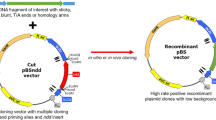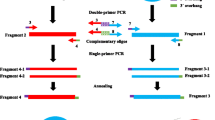Summary
Using the bifunctional cloning vehicle pHP13, which carries the replication functions of the cryptic Bacillus subtilis plasmid pTA1060, the effects of BsuM restriction on the efficiency of shotgun cloning of heterologous Escherichia coli DNA were studied. In a restriction-deficient but modification-proficient mutant of B. subtilis, clones were obtained at a high frequency, comparable to frequencies normally obtained in E. coli (104 clones per μg target DNA). Large inserts were relatively abundant (26% of the clones contained inserts in the range of 6 to 15 kb), which resulted in a high average insert length (3.6 kb). In the restriction-proficient B. subtilis strain, the class of large inserts was underrepresented. Transformation of B. subtilis with E. coli-derived individual recombinant plasmids was affected by BsuM restriction in two ways. First, the transforming activities of recombinant plasmids carrying inserts larger than 4 kb, were, in comparison with the vector pHP13, reduced to varying degrees in the restricting host. The levels of the reduction increased with insert length, resulting in a 7800-fold reduction for the largest plasmid used (pC23; insert length 16 kb). Second, more than 80% of the pC23 transformants in the restricting strain contained a deleted plasmid. In the non-restricting strain, the transforming activities of the plasmids were fairly constant as a function of insert length (in the range of 0–16 kb), and no structural instability was observed. It is concluded that for shotgun cloning in B. subtilis, the use of restriction-deficient strains is highly preferable. Evidence is presented that in addition to XhoI other sequences are involved in BsuM restriction. It is postulated that AsuII sites are additional target sites for BsuM restriction.
Similar content being viewed by others
References
Biswal N, Kleinschmidt AK, Spatz HC, Trautner TA (1967) Physical properties of the DNA of bacteriophage SP50. Mol Gen Genet 100:39–55
Bron S, Luxen E (1985) Segregational instability of pUB110-derived recombinant plasmids in B. subtilis. Plasmid 14:235–244
Bron S, Venema G (1972) Ultraviolet inactivation and excision repair in Bacillus subtilis. I. Construction and characterization of a transformable eightfold auxotrophic strain and two ultraviolet-sensitive derivatives. Mutat Res 15:1–10
Canosi U, Morelli G, Trautner TA (1978) The relationship between molecular structure and transformation efficiency of some S. aureus plasmids isolated from B. subtilis. Mol Gen Genet 166:259–267
Doi RH (1984) Genetic engineering in Bacillus subtilis. In: Russell GE (ed) Biotechnology and genetic engineering reviews, vol 2. Intercept, Newcastle upon Tyne, England, pp 121–155
Dubnau D (1983) Molecular cloning in Bacillus subtilis. In: Inouye M (ed) Experimental manipulation of gene expression. Academic Press, New York, pp 33–51
Guha S (1985) Determination of DNA sequences containing methylcytosine in Bacillus subtilis Marburg. J Bacteriol 163:573–579
Gryczan TJ (1982) Molecular cloning in Bacillus subtilis. In: Dubnau D (ed) The molecular biology of the bacilli. Academic Press, New York, pp 307–327
Gryczan TJ, Contente S, Dubnau D (1980) Molecular cloning of heterologous chromosomal DNA by recombination between a plasmid vector and a homologous resident plasmid in B. subtilis. Mol Gen Genet 177:459–467
Hoch FA, Barot M, Anagnostopoulos C (1967) Transformation and transduction in recombination-defective mutants of Bacillus subtilis. J Bacteriol 122:25–33
Horinouchi H, Weisblum B (1982a) Nucleotide sequence and functional map of pE194, a plasmid that specifies inducible resistance to macrolide lincosamide, and streptogramin type B antibiotics. J Bacteriol 150:802–814
Horinouchi H, Weisblum B (1982b) Nucleotide sequence and functional map of pC194, a plasmid that specifies inducible chloramphenicol resistance. J Bacteriol 150:815–825
Iordanescu S, Surdeanu M, Della Latta P, Novick R (1978) Incompatability and molecular relationships between small staphylococcal plasmids carrying the same resistance marker. Plasmid 1:468–479
Ish-Horowicz D, Burke FJ (1981) Rapid and efficient cosmid cloning. Nucleic Acids Res 9:2989–2999
Jentsch S (1983) Restriction and modification in Bacillus subtilis: sequence specifities of restriction/modification systems BsuM, BsuE and BsuF. J Bacteriol 156:800–808
Maniatis T, Fritsch EF, Sambrook J (1982) Molecular cloning, a laboratory manual. Cold Spring Harbor Laboratory, Cold Spring Harbor, New York
Marinus MG (1973) Location of DNA methylation genes on the Escherichia coli K-12 map. Mol Gen Genet 127:47–55
Michel B, Niaudet B, Palla E, Ehrlich SD (1980) DNA cloning in Bacillus subtilis. III. Efficiency of random segment cloning and insertional inactivation vectors. Gene 12:147–154
Michel B, Niaudet B, Ehrlich SD (1982) Intramolecular recombination during plasmid transformation of Bacillus subtilis competent cells. EMBO J 1:1565–1571
Ostroff GR, Pène JJ (1983) Molecular cloning with bifunctional plasmid vectors in Bacillus subtilis. III. Isolation of a spontaneous mutant of B. subtilis with enhanced transformability for Escherichia coli propagated chimaeric plasmid DNA. J Bacteriol 156:934–936
Ostroff GR, Pène JJ (1984a) Molecular cloning with bifunctional plasmid vectors in Bacillus subtilis. I. Construction and analysis of B. subtilis clone banks in E. coli. Mol Gen Genet 193:299–305
Ostroff GR, Pène JJ (1984b) Molecular cloning with bifunctional plasmid vectors in Bacillus subtilis. II. Transfer of sequences propagated in Escherichia coli to B. subtilis. Mol Gen Genet 193:306–311
Rutberg L (1969) Mapping of a temperate bacteriophage active on Bacillus subtilis. J Virol 3:38–44
Saito H, Shibata T, Ando T (1979) Mapping of genes determining nonpermissiveness and host-specific restriction to bacteriophages in Bacillus subtilis Marburg. Mol Gen Genet 170:117–122
Shibata T, Ando T (1974) Host controlled modification and restriction in Bacillus subtilis. Mol Gen Genet 131:275–280
Smith H, de Vos W, Bron S (1983) Transformation in Bacillus subtilis. Properties of DNA-binding-deficient mutants. J Bacteriol 153:12–20
Tanaka T (1979) Restriction of plasmid-mediated transformation in Bacillus subtilis. Mol Gen Genet 175:235–237
Tanaka T, Sakaguchi K (1978) Construction of a recombinant plasmid composed of B. subtilis leucine genes and B. subtilis (natto) plasmid: its use as a cloning vehicle in B. subtilis 168. Mol Gen Genet 165:269–276
Uozumi T, Hoshino T, Miwa K, Horinouchi S, Beppu T, Arima K (1977) Restriction and modification in Bacillus species. Genetic transformation of bacteria with DNA from different species, part I. Mol Gen Genet 152:65–69
Uozumi T, Ozaki A, Beppu T, Arima K (1980) New cryptic plasmid of Bacillus subtilis and restriction analysis of other plasmids found by general screening. J Bacteriol 142:315–318
Vieira J, Messing J (1982) The pUC plasmids, an M13mp7-derived system for insertion mutagenesis and sequencing with synthetic universal primers. Gene 19:259–268
Venema G, Pritchard RH, Venema-Schröder T (1965) Fate of transforming deoxyribonucleic acid in Bacillus subtilis Marburg. J Bacteriol 89:1250–1255
Yanisch-Perron C, Vieira J, Messing J (1985) Improved M13 phage cloning vectors and host strains: nucleotide sequences of M13mp18 and pUC19 vectors. Gene 33:103–119
Author information
Authors and Affiliations
Additional information
Communicated by W. Gajewski
Rights and permissions
About this article
Cite this article
Haima, P., Bron, S. & Venema, G. The effect of restriction on shotgun cloning and plasmid stability in Bacillus subtilis Marburg. Molec Gen Genet 209, 335–342 (1987). https://doi.org/10.1007/BF00329663
Received:
Issue Date:
DOI: https://doi.org/10.1007/BF00329663




